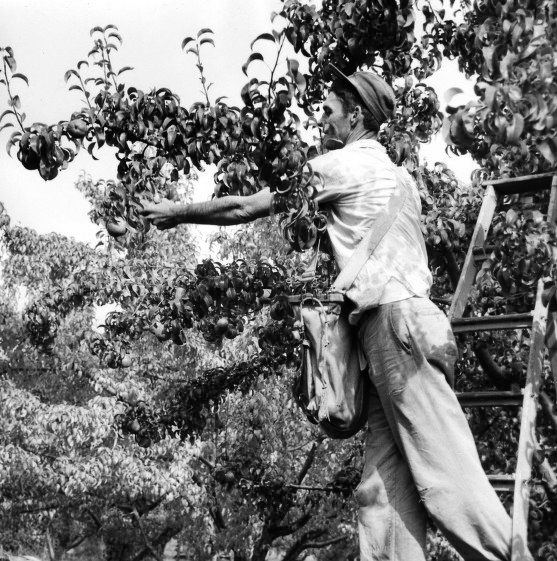Hazelnuts, also called filberts, have provided food for Indigenous peoples in the Northern Hemisphere since the glacial age. Two varieties are important to Oregon. Corylus Cornuta var. californica grows wild in the state and is now planted for erosion control and wildlife habitat. C. avellana L., which settlers brought to Oregon Territory from England and France in the 1850s, became the genesis of the hazelnut industry in Oregon. The Willamette Valley, with its fertile soil and mild climate, is now home to 99.9 percent of the U.S. commercial hazelnut industry.
Hazelnut trees are unusual in that they pollinate during winter, when their catkins (flowering stems) elongate and pollen travels by wind to tiny red flowers on the branches. Varieties of hazelnut, chosen by farmers according to the trees’ ability to pollinate one another, are planted in evenly spaced rows. Nuts fall from the trees in September and are mechanically harvested from clean orchard floors. They are washed, dried, and sold in the shell or cracked and sold as kernels. Oregon hazelnuts are in demand throughout the world because of their high quality and large size.
The oldest Oregon hazelnut orchard, Dorris Ranch, was planted in 1903 near Eugene. The nonprofit, working ranch is still in production.
In 2008, 650 farm families in Oregon, many multi-generational, grew hazelnuts on 30,100 acres and produced 32,000 tons of nuts. From 2004 through 2008, the average farm-gate price that Oregon farmers received for their hazelnuts—that is, the value of the nuts when they left the farm—was $60 million. In 1989, the Oregon legislature named the hazelnut the Oregon state nut.
-
![]()
Woman gathering hazelnuts in orchard, c. 1910.
Oregon Historical Society Research Library, Digital Collections, OrgLot78_B5F5_018
Related Entries
-
![Cranberry Industry]()
Cranberry Industry
The Oregon cranberry is prized for its deep red color, which growers sa…
-
![Hop Industry]()
Hop Industry
Hops are perennial, cone-producing, climbing plants native to Europe, A…
-
Marionberry
The blackberry cultivar, Marion, often called "marionberry" by consumer…
-
![Oregon State symbols]()
Oregon State symbols
Oregon has a number of officially designated symbols, ranging from thos…
-
Pears and the pear industry
European pears (Pyrus communis) thrive in the temperate climate of the …
Map This on the Oregon History WayFinder
The Oregon History Wayfinder is an interactive map that identifies significant places, people, and events in Oregon history.
Further Reading
Carey, C.H. History of Oregon. Vol. 1. Chicago: The Pioneer Historical Publishing Co., 1922. 799-805.
Duke, James. Handbook of Nuts. Boca Raton, Fla: CRC Press, Inc., 1989. pp.126-127.






